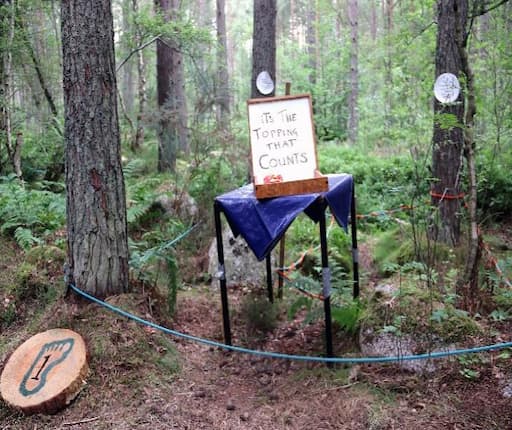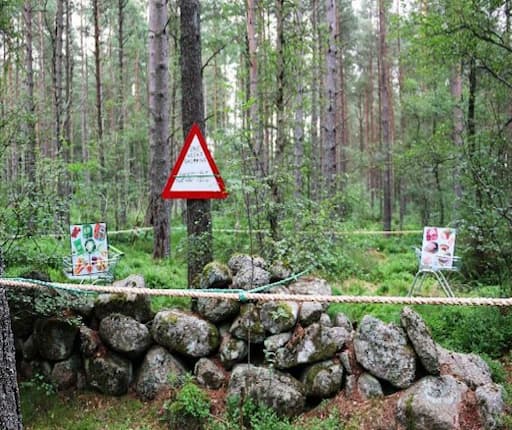Climate Change Project
Carbon Footprint Trail at the Bennachie Visitor Centre
What is the carbon footprint trail?
The aim of the trail is to show how nature is helping us address climate change – what it can do and what it can’t do. The trail is set in woodland because trees are hugely important for capturing carbon dioxide (CO2) from the air.
How does nature help us with climate change?
Carbon dioxide is food for plants. Plants capture CO2 from the air, zap it with sunlight and convert it into energy which they use to grow (photosynthesis). Big, fast-growing plants need more energy to grow, so they capture more CO2 food than smaller, slower-growing plants. Trees are a bit like us - when they are tiny seedings and saplings like small children, they don’t need much CO2 food, but fast-growing trees need loads of energy and loads of food like youths and young adults, but as they move into old age trees need less food.
Trees are very good at storing carbon.As woody plants, about 50% of a tree’s biomass is carbon mostly stored in the tree trunk and branches. Trees also pass carbon below ground to its roots and associated fungi and in the soil.
Non-woody plants don’t capture as much carbon dioxide as trees, but they too send carbon below ground into the soil where it is stored. Peat is especially good at storing carbon.
So are plants the solution to climate change? Sadly not, nature can’t capture and store all the greenhouse gases we’ve produced in recent years. Some researchers estimate that nature-based solutions can cope with about one third of emissions, but we’ll need to find other ways to remove greenhouse gases from the air. We would be wise to conserve all natural habitats, not only because we enjoy them, but also because plants are very good at capturing CO2 from the air far more efficiently than man-made technology.
Who made the trail?
The trail was made by a group of local people concerned about climate change and the biodiversity crisis who wanted to do something for COP26. They made the trail working with the Bailies of Bennachie, Forestry and Land Scotland (FLS), Outdoor Woodland Learning Scotland North East Group (OWLS), Aberdeenshire Council Ranger Service and North-East Scotland Biodiversity Partnership.
Their contact e-mail is climatechange.bennachie@btinternet.com.
Why did they make the trail?
The group made the trail (which is temporary) for COP26, the global conference on climate change which will be held in Glasgow in November 2021. At the conference world leaders will discuss how to reduce emissions of greenhouse gases. They will also discuss who should pay for what. In general, wealthy countries have emitted more greenhouse gases than poorer countries. Some low-income countries have emitted very few greenhouse gases, but they are suffering serious consequences from climate change which is proving very expensive for them to manage.
The group used information on carbon footprints from the book ‘How Bad are Bananas – the Carbon Footprint of Everything’ by Mike Berners-Lee. To work out how much nature does for us, they used recent scientific reports to calculate the ability of natural habitats to capture (sequester) and store carbon (carbon sinks).
They wanted to find out what local habitats do for us, rather than far-away places like the Amazon rain forest or Arctic ice sheets. They were shocked to discover that Bennachie (on the land managed by Forest and Land Scotland) could capture the greenhouse gas emissions from fewer than 20% of the population of Inverurie. This brought the scale of the climate change challenge facing us all right home to our own doorstep.
What can we do about climate change?
As individuals we can find out how to reduce our own carbon footprint by using a carbon footprint calculator such as Pawprint which also uses Mike Berners-Lee’s data.
But there is a limit to how much individuals can do. Far more significantly, as a society we need to reduce our emissions of greenhouse gases by making changes to the way we live – changes to the food we eat, the power we use, how we travel, how we heat our homes, the goods we buy, the waste we throw away and how we use land. This scale of change needs action from everyone - from the giant global oil companies right down to small local businesses. The changes have to be driven by governments, which is why COP26 is so important. The Scottish government has set a target to reach net zero by 2045 and we are all going to have to make changes to our lifestyles to achieve this.
Download Guide to the Carbon Trail Installations (PDF).
Educational Information
The Carbon Footprint and Nature Trail on Bennachie
The trail is set in pine woodland by the Bennachie Visitor Centre.
The trail encircles the area of woodland needed to capture the annual greenhouse gas emissions from the average UK citizen, around the trail there are various everyday installations.
At some of these installations, roped areas show the amount of conifer woodland needed to capture the greenhouses gases emitted by various items and activities in everyday life.

Food
In the UK about a quarter of the average person’s carbon footprint is food.
Pizza - It’s the topping that counts – the carbon footprint of a meat feast pizza is twice as big as a margherita pizza. What also makes a difference is how the pizza is delivered – by bike is better than by car. What you do with the box when you’ve finished with it?

Food - A Week’s Shopping
People who eat meat and dairy have a bigger carbon footprint than those who are vegetarian or vegan. Food which is transported by air has a big footprint too, so choose local food if you can. The massive amount of food waste is also a big concern in the UK.

Home
Shower or bath? - What makes the difference is how much water is used and how the water is heated. Heating water with renewables such as solar panels or wind energy is better than using fossil fuels.

Clothes and Washing Line
Drying clothes on a washing line is more climate friendly than using a tumble drier.
Clothing and textiles make up about 2% of the footprint of the average UK citizen, but it can be 5 to 10 times higher for people who like fast fashion and buy lots of clothes.
An area of woodland 5m x 5m is needed to capture the greenhouse gases emitted from the manufacture of a single pair of jeans.

Travel - Commuting
People’s travel patterns vary a lot depending on where they live and work (or go to school).
This installation shows how much woodland is needed to capture the CO2 emitted when commuting between Inverurie and Aberdeen using different modes of transport.
Most powered vehicles are powered by fossil fuels, so it’s better to share cars or use public transport if possible. Driving alone in a fuel-guzzling SUV is not planet-friendly.

Travel - Holidays and Business
Many people never fly at all, but those people who are frequent flyers have a large carbon footprint. taking a holiday including a long-haul flight significantly increases your carbon footprint.
It’s more climate friendly to travel to London by train than by plane.
Transporting goods by air, such as asparagus from Peru, tends to make their carbon footprint much larger than goods which are transported by land or sea.

Electronic Gadgets
A lot more carbon is used to manufacture (called embodied carbon) the electronic gadgets we use at home and in the office than when we actually use them – whether this is watching TV, making a phone call or sending an e-mail.
Recycling our electronic gadgets is a good thing to do, but moving to a circular economy is better.
What about the flowers? Out-of-season cut flowers are grown either using artificial heat or are flown to the UK often from places as far away as Kenya, neither are good news for the climate change – “one of the most carbon-unfriendly ways of getting rid of your cash”. Grow and pick your own flowers if you can or buy locally grown flowers.
Reducing your Carbon Footprint – Where To Get More Information
General
Everything we buy has a carbon cost
Food
Climate change food calculator: What's your diet's carbon footprint?
Home and Business
How to cut the carbon out of your heating
Travel
Traffic Scotland Carbon Calculator
Net Zero Nation – Active Travel
Net Zero Nation – Public Transport
Net Zero Nation – Electric Vehicles
Reducing Car Travel in Scotland
Electronic Gadgets
Guide to Your Digital Footprint – Creative Scotland

